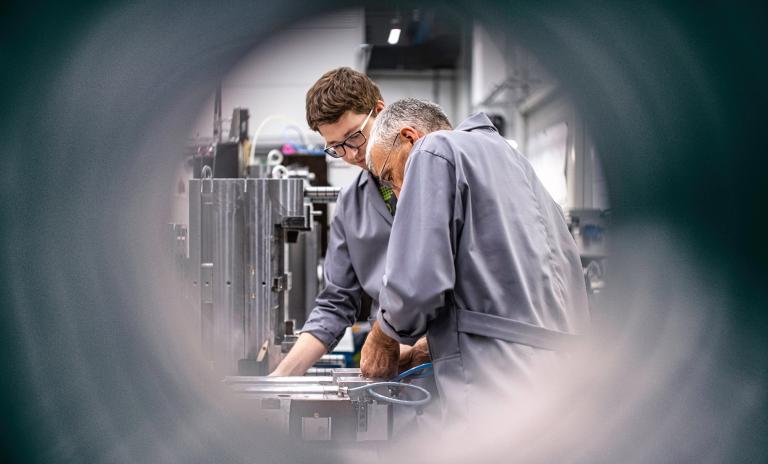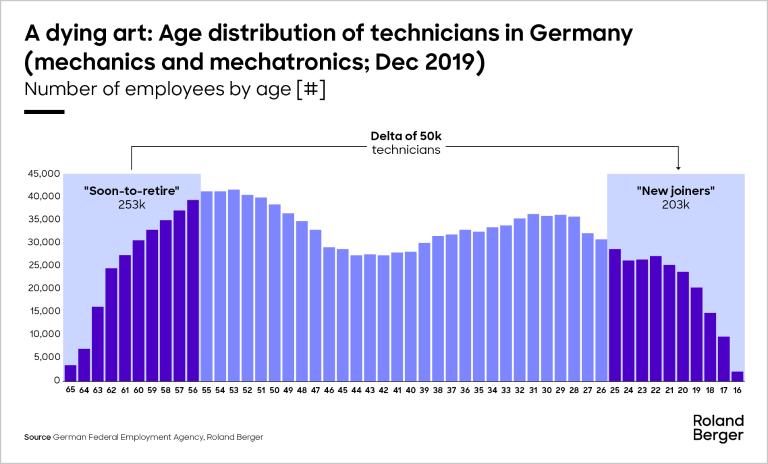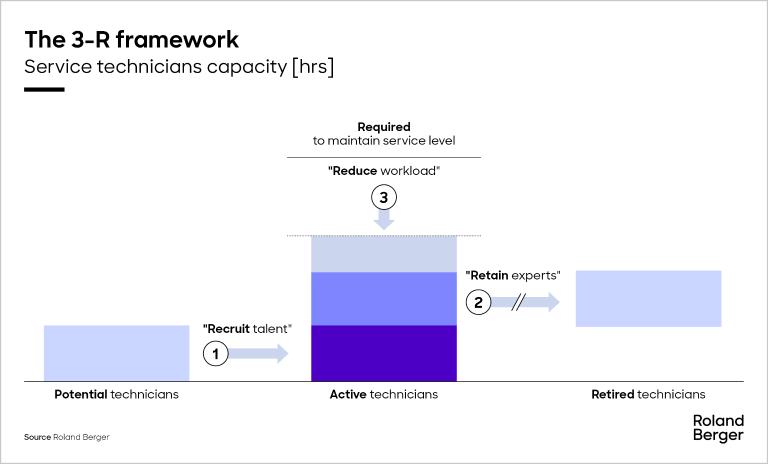Several factors contribute to the issue, such as a declining working-age population, diminished appeal of production jobs, the growing complexity of digitalization, and global competition for skilled workers.

_download_preview.jpg)
Overcoming the service workforce crisis
How industrial machinery companies can recruit talent, retain experts and reduce workloads to ensure growth
In recent years, service has emerged as a primary driver for revenue and profit growth in the industrial machinery sector. But this promising trajectory now faces a significant challenge – a growing service workforce crisis. Demand for skilled service technicians is falling far short of supply. In this study, experts at Roland Berger and the University of St- Gallen propose a strategy and practical solutions to address the crisis.

"Proactively addressing the challenges helps companies mitigate the workforce shortage and position themselves as industry leaders."
Service revenue in the industrial machinery sector was on a tear before the COVID-19 pandemic. Between 2013 and 2019, service revenue at the median industrial machinery company grew by 8% per year, outpacing non-service revenue growth of 5%. Now no longer considered an afterthought, the sector has come to rely on the growth and above-average margins generated by service. The pressure to generate revenue and margins from the installed base will likely only increase.
However, since the pandemic, service revenue growth has tailed off. In the 2019-22 period, service revenue grew at only 2% per year, while non-service growth remained stable at 5%. Today, significant challenges stand in the way of continued service growth. But while technical issues, business model challenges and increasing external margin pressure are being addressed, one fundamental challenge remains – demand for skilled service technicians is rising, creating a service workforce crisis.
Industrial machinery companies must act quickly to address this crisis and ensure a stable path of continued growth. The question is – how? In this report, we first analyze the complexities of the service workforce crisis, using research, interviews and a survey of industry technicians carried out as part of the St. Gallen Service Technician (SGST) Study by the University of St. Gallen, Switzerland. We then offer a framework and levers to mitigate the impact of the crisis, based on a 3-R strategy: Recruit (talent), Retain (experts) and Reduce (workload).
A growing crisis
Service technicians are at the heart of any service business. From repairs and maintenance checks to upgrades and retrofits, a lack of on-site service technicians means a lack of revenue. And with ever-more sophisticated machinery and service management expanding into value-added and digital services, technicians’ skills need to grow with the company.
But attracting and retaining skilled employees is an increasingly difficult task. Demographic trends, coupled with changes in work and travel preferences and increasing requirements for digital skillsets, have created a perfect storm. The data reflects this: The number of job openings at German mechanical engineering companies has increased by over 150% in the past ten years. This equates to an annual growth in open positions of 10%, a significant upwards trend. Indeed, our analysis shows a shortfall of at least 50,000 technicians in mechanics and mechatronics that is likely to emerge over the coming decade.
"Our 3-R framework identifies six practical levers that offer actionable solutions to tackle the service workforce crisis."
To address these worrying workforce trends, companies must act now to ensure the future success of their service businesses. Organizations must become more proactive in Recruiting, reinventing the service technician job and turning it into a desirable choice for young talent. They need to get creative to Retain their existing base of experienced and highly skilled technicians, preventing them from leaving field service teams. And they need to Reduce the technician capacity required to support their targeted service levels and business growth.
The 3-R framework
Tackling the service workforce crisis requires more than a piecemeal approach. To successfully meet their needs, service businesses must implement an integrated service workforce strategy that addresses recruiting talent, retaining experts and reducing workloads. Our 3-R framework identifies six practical levers that offer actionable solutions to tackle the service workforce crisis. The levers and solutions (summarized below) are detailed in the full report, where we also present best practices from experienced service professionals in a variety of industries. These demonstrate how the levers can be put into action and how they can make a positive impact.
Recruit (talent)
Put your company on the map: Businesses must engage with potential candidates early on to market service technician jobs as an attractive career prospect. They must also promote service’s excellent career prospects.
Professionalize talent acquisition: Implementing a customized approach to service technician recruitment, for example by using specialized HR partners, is critical to finding and attracting the right talent. In addition, consider recruiting talent from abroad and simplifying the application process with digital tools.
Retain (experts)
Enhance working conditions: Companies should establish clear career paths for employee growth understanding, motivation and engagement. They should also improve training, ensure diverse career opportunities and experiences and reward achievements.
Adapt compensation: An effective approach here involves providing salary increases and better monetary incentives based on individual performance. High-value non-financial incentives, such as desirable company cars, quality health care and generous travel budgets, are also essential.
Reduce (workload)
Digitalize the customer journey: Consider using remote services for technical support and equipping customers with technology such as augmented reality (AR) glasses to remotely diagnose problems. Also, integrate a seamless way to engage with (technical) support into on-device software to ensure that customer requests arrive with all required information.
Increase process efficiency: Improve field service planning by leveraging cross-country and cross-segment staffing to optimize capacity balancing. To lower administrative overheads, streamline administrative tasks, reduce bureaucratic workloads and eliminate strenuous contract clauses.
We believe that through strategic planning, adaptability and a focus on talent management, companies can still thrive in a competitive market and maintain a sustainable advantage. For more information, please download a copy of the full report or contact one of our experts. We look forward to hearing from you.
Register now to access the full study, to learn more about how industrial machinery companies can attract top talent, retain industry experts, and streamline operations for sustainable growth.







